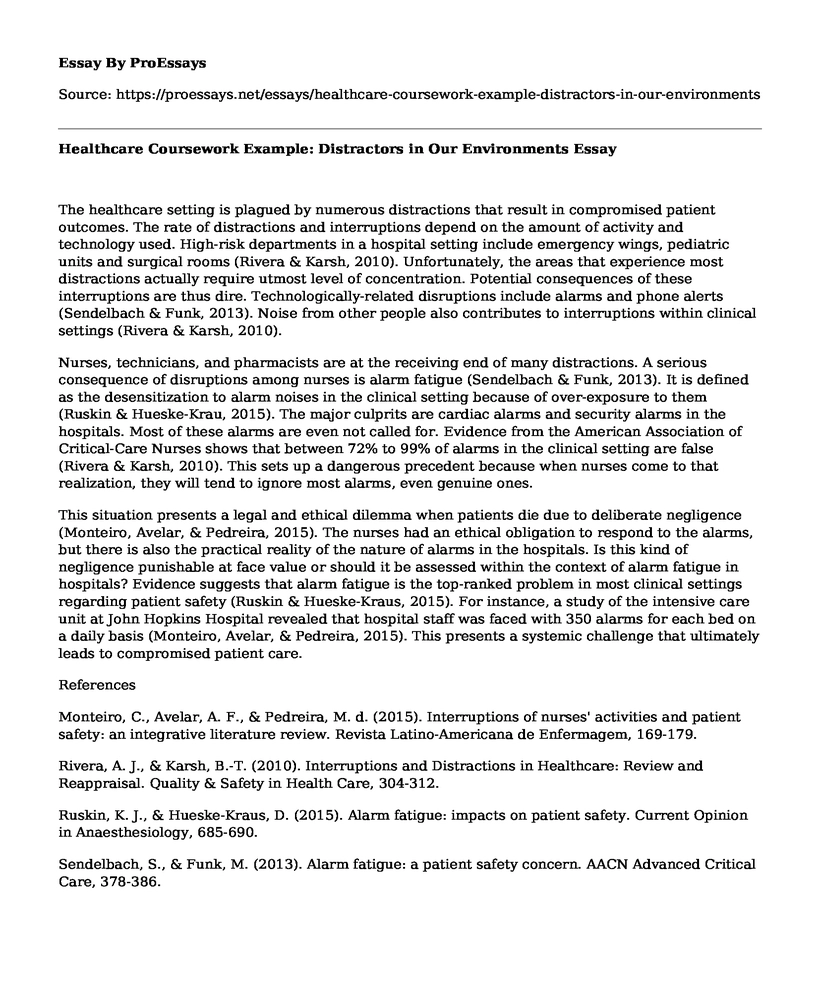The healthcare setting is plagued by numerous distractions that result in compromised patient outcomes. The rate of distractions and interruptions depend on the amount of activity and technology used. High-risk departments in a hospital setting include emergency wings, pediatric units and surgical rooms (Rivera & Karsh, 2010). Unfortunately, the areas that experience most distractions actually require utmost level of concentration. Potential consequences of these interruptions are thus dire. Technologically-related disruptions include alarms and phone alerts (Sendelbach & Funk, 2013). Noise from other people also contributes to interruptions within clinical settings (Rivera & Karsh, 2010).
Nurses, technicians, and pharmacists are at the receiving end of many distractions. A serious consequence of disruptions among nurses is alarm fatigue (Sendelbach & Funk, 2013). It is defined as the desensitization to alarm noises in the clinical setting because of over-exposure to them (Ruskin & Hueske-Krau, 2015). The major culprits are cardiac alarms and security alarms in the hospitals. Most of these alarms are even not called for. Evidence from the American Association of Critical-Care Nurses shows that between 72% to 99% of alarms in the clinical setting are false (Rivera & Karsh, 2010). This sets up a dangerous precedent because when nurses come to that realization, they will tend to ignore most alarms, even genuine ones.
This situation presents a legal and ethical dilemma when patients die due to deliberate negligence (Monteiro, Avelar, & Pedreira, 2015). The nurses had an ethical obligation to respond to the alarms, but there is also the practical reality of the nature of alarms in the hospitals. Is this kind of negligence punishable at face value or should it be assessed within the context of alarm fatigue in hospitals? Evidence suggests that alarm fatigue is the top-ranked problem in most clinical settings regarding patient safety (Ruskin & Hueske-Kraus, 2015). For instance, a study of the intensive care unit at John Hopkins Hospital revealed that hospital staff was faced with 350 alarms for each bed on a daily basis (Monteiro, Avelar, & Pedreira, 2015). This presents a systemic challenge that ultimately leads to compromised patient care.
References
Monteiro, C., Avelar, A. F., & Pedreira, M. d. (2015). Interruptions of nurses' activities and patient safety: an integrative literature review. Revista Latino-Americana de Enfermagem, 169-179.
Rivera, A. J., & Karsh, B.-T. (2010). Interruptions and Distractions in Healthcare: Review and Reappraisal. Quality & Safety in Health Care, 304-312.
Ruskin, K. J., & Hueske-Kraus, D. (2015). Alarm fatigue: impacts on patient safety. Current Opinion in Anaesthesiology, 685-690.
Sendelbach, S., & Funk, M. (2013). Alarm fatigue: a patient safety concern. AACN Advanced Critical Care, 378-386.
Cite this page
Healthcare Coursework Example: Distractors in Our Environments. (2021, Sep 02). Retrieved from https://proessays.net/essays/healthcare-coursework-example-distractors-in-our-environments
If you are the original author of this essay and no longer wish to have it published on the ProEssays website, please click below to request its removal:
- The Nature and Background of the Emergency Response - Article Analysis Essay
- Level of Education of the Nurse Paper Example
- Volunteering in a Physical Therapy Clinic in an Underprivileged Part of Los Angeles
- Critical Analysis of Health Disparities by Race and Class: Why Both Matter
- Delta Health Care Patient Satisfaction Paper Example
- Cross-Cultural Perceptions of Body Image: A Review of Obesity Etiology - Essay Sample
- Executive Summary for Administration of a University Medical Center







